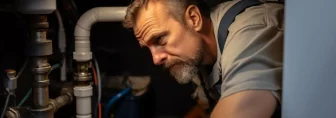Maintenance AND Repairs OF Commercial Overhead Doors: Easy Tips

Commercial overhead doors are a vital element in various industries, ensuring efficient operations and safeguarding valuable assets. These doors, including sectional doors, rolling steel doors, and high-speed fabric doors, are designed to withstand the demanding environments of industrial and commercial settings.
In this comprehensive guide, we’ll delve into the significance of regular maintenance and timely repairs for commercial overhead doors, offering valuable tips to optimize their longevity and performance.
Understanding Commercial Overhead Doors
Commercial overhead doors are engineered to cater to specific operational needs, providing security, insulation, and efficiency. These doors come in different types, each with unique benefits:
A. Sectional Doors
Sectional doors are a popular choice for various commercial establishments due to their durability and insulation properties. They consist of panel sections connected with hinges, allowing the door to bend and follow a curved path during its upward and downward movement. These doors offer excellent thermal efficiency, which is crucial for maintaining indoor temperatures in warehouses and industrial facilities.
B. Rolling Steel Doors
Rolling steel doors are designed for high-traffic areas and locations where security is paramount. Constructed from interlocking slats of steel, these doors coil into a roll when lifted, offering excellent security and durability. They are ideal for loading docks, warehouses, and facilities that require frequent access.
C. High-Speed Fabric Doors
High-speed fabric doors are engineered for rapid opening and closing, enhancing efficiency and minimizing energy loss. They are ideal for spaces where maintaining temperature control is crucial, ensuring the indoor environment remains optimized. These doors find applications in cold storage facilities, cleanrooms, and spaces where traffic flow is high.
Importance Of Regular Maintenance
Regular maintenance is a fundamental requirement to ensure the optimal functionality and longevity of commercial overhead doors. Neglecting maintenance can lead to unexpected breakdowns, costly repairs, and compromised safety within the workplace. Here’s why regular maintenance is crucial:
A. Enhanced Safety
A well-maintained door operates safely, reducing the risk of accidents and injuries among employees and visitors. Safety should always be a priority in any workplace, and regular maintenance contributes to creating a safe environment. Additionally, regular safety inspections can detect potential hazards, ensuring compliance with safety standards.
B. Longevity
Regular maintenance significantly extends the lifespan of the doors, preserving your initial investment and saving costs in the long run. With proper care and attention, these doors can operate efficiently for many years, providing excellent value. Preventative maintenance, such as identifying and replacing worn-out parts, helps avoid major breakdowns that could necessitate costly replacements.
C. Operational Efficiency
A well-maintained door operates smoothly, ensuring efficiency in daily operations and minimizing downtime. Operational efficiency is essential for productivity, and a properly functioning door is a cornerstone of a productive workplace. Moreover, efficient doors contribute to streamlined logistics and supply chain operations, particularly in settings where goods need to move in and out frequently.
D. Cost Savings
Timely identification and fixing of issues during maintenance prevent minor problems from escalating into major, expensive repairs. It’s a cost-effective approach that ultimately saves the business money and resources. By conducting regular maintenance, businesses can strategically allocate budgets, minimizing unforeseen repair costs and optimizing the door’s efficiency.
Maintenance Tips For Commercial Overhead Doors
Implementing a regular maintenance routine is key to keeping commercial overhead doors in optimal condition. Here are essential maintenance tips to follow:
A. Cleaning and Lubricating
Regularly clean the tracks, rollers, and hinges of the door to remove dust, debris, and any obstructions. Lubricate these components using appropriate lubricants to ensure smooth movement and prevent friction-related issues. Effective lubrication enhances the door’s performance, reduces wear and tear, and contributes to a quieter operation.
B. Hardware Inspection
Periodically check and tighten all hardware such as screws, bolts, and nuts. Over time, these components may become loose due to the door’s constant movement. Tightening them ensures the door operates correctly and reduces wear and tear on other parts. Investing in high-quality hardware and conducting routine checks prevents unexpected malfunctions and ensures structural integrity.
C. Safety Features Calibration
Test and calibrate safety features like sensors and emergency stop mechanisms to ensure they function correctly and promptly when needed. These safety mechanisms are critical for preventing accidents and injuries. Regular testing guarantees compliance with safety regulations, fostering a secure working environment.
D. Weather Stripping Inspection
Inspect the weather stripping and seals to guarantee they provide proper insulation and protection against external elements, maintaining the indoor climate and energy efficiency of the building. Damaged weather stripping can lead to energy wastage and compromise the door’s insulation capabilities. Replacing worn-out weather stripping is a cost-effective measure to maintain energy efficiency.
E. Preventing Corrosion
Protect the door against corrosion by applying appropriate coatings or paints, especially in areas with high humidity or exposure to corrosive substances. Corrosion can significantly reduce the door’s lifespan and compromise its structural integrity. Regularly inspect the door’s surface for signs of corrosion and take proactive measures to address it promptly.
When To Seek Professional Assistance
While regular maintenance tasks can be handled in-house, certain repairs and maintenance tasks require professional expertise. Here are scenarios where seeking professional assistance is recommended:
A. Major Repairs
For significant repairs such as motor replacement, spring adjustments, or track realignment, it’s best to engage a professional technician. These repairs involve specialized knowledge and equipment that professionals possess, ensuring the job is done accurately and safely.
B. Electrical Issues
Any electrical issues within the door mechanism should be addressed by a licensed electrician. Working with electrical components carries inherent risks, and only a qualified professional should handle electrical repairs and installations.
C. Structural Damage
If the door has suffered significant structural damage due to accidents or harsh weather conditions, professional commercial door repair services are necessary. Attempting to repair structural damage without the appropriate expertise can worsen the situation and compromise the door’s functionality.
Conclusion
Regular maintenance and timely repairs are the foundation for ensuring the optimal functionality and longevity of commercial overhead doors. By following the provided tips and seeking professional assistance when needed, businesses can keep their operations smooth, secure, and cost-effective.
For reliable maintenance and repair services for your commercial overhead doors, view services. Investing in the upkeep of these doors is not just a matter of convenience; it’s a strategic decision that enhances safety, prolongs the life of the equipment, and ultimately saves on costs.
In conclusion, prioritize the maintenance and repairs of your commercial overhead doors to maintain a safe and efficient workplace. By doing so, you ensure that these vital components of your facility function at their best, contributing to the overall productivity and success of your business.
Read Also:




























